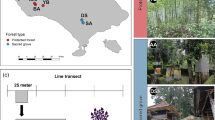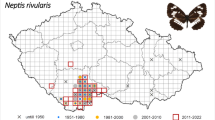Abstract
In the Fathala Forest, Saloum Delta National Park, Senegal, in 1974–1976 and 1988–2002, we studied the northernmost populations of the endangered Temminck’s red colobus (Procolobus badius temmincki). Drastic habitat changes in the last 30 yr have reduced the forests by > 50% (75% in the gallery forests used by the red colobus). The woody species diversity decreased by > 30%. Despite these changes, the red colobus population only decreased from ca. 600 to ca. 500 individuals. We examined the ecological conditions and behavioral adaptations that may have influenced survival of the population. We found that 5 major adaptations have emerged in the last 30 yr that may have influenced the survival of red colobus at Fathala: (1) frugivory, (2) terrestriality, (3) tendency to form polyspecific associations with green monkeys, (4) tendency to frequent more open habitats, and (5) use of mangrove swamps for refuge and forage. By develo** these adaptations, red colobus demonstrated their ability to persist in degraded habitats of the Fathala Forest. Preserving the forest should ensure the conservation of the red colobus population there.
Similar content being viewed by others
References
Aubreville, A. (1948). La Casamance. L’Agronomie Tropicale 3(1–7): 25–52.
Chapman, C. A., Balcomb, S. R., Gillespie, T. R., Skorupa, J. P., and Struhsaker, T. T. (2000). Long-term effects of logging on African primate communities: A 28-year comparison from Kibale National Park, Uganda. Conserv. Biol. 14: 207–217.
Chapman, C. A., Lawes, M. J., Naughton-Treves, L., and Gillespie, T. (2003). Primate survival in community-owned forest fragments: are metapopulation models useful amidst intensive use? In: Marsh, L. K. (ed.), Primates in Fragments: Ecolgy and Conservation. Kluwer Academic/Plenum Publishers, Dordrecht/New York pp. 63–78.
Charter, J. R., and Keay, W. J. (1960). Assessment of the Olokemeji fire-control experiment (investigation 254) 28 years after institution. Nigerian Forest. Inf. Bull. 3: 1–31.
Clutton-Brock, T. H. (1972). Feeding and Ranging Behaviour of the Red Colobus Monkeys, PhD Thesis, Cambridge University, Cambridge.
Clutton-Brock, T. H. (1973). Feeding levels and feeding sites of Red Colobus (Colobus badius tephrosceles) in the Gombe National Park. Folia Primatol. 19: 368–379.
Davies A. G., and Oates J. F. (1994). Colobine Monkeys: Their Ecology, Behaviour and Evolution, Cambridge University Press, Cambridge.
Decker, B. S. (1994). Effects of habitat disturbance on the behavioral ecology and demography of the Tana River red colobus (Colobus badius rufomitratus). Int. J. Primatol. 15 (5): 703–737.
Diouck, D. (1999). Adaptations aux modifications du milieu des Colobes bais (Colobus badius temmincki) de la forêt de Fathala, Parc National du Delta du Saloum, Sénégal, Thèse de 3e cycle. UCAD, Dakar.
Diouck, D., Galat-Luong, A., and Galat, G. (1996). The Fathala forest red colobus (Colobus badius temmincki): Twenty years of Delay. Folia Primatol. 67 (2): 89.
Dorst, J., and Dandelot, P. (1970). A Field Guide to the Larger Mammals of Africa, Collins, St James Place, London.
Dupuy, A. (1972). Prospection faunistique en hélicoptère au-dessus du Delta du Sine-Saloum (Sénégal). Notes africaines. Institut Fondamental d’Afrique Noire 136: 119–121.
Dupuy, A. R., and Verschuren, J. C. (1982). Notes sur les grands Mammifères “relictuels” de la région du Parc national du Delta du Saloum. Mémoires de l’Institut Fondamental d’Afrique Noire 92: 279–292.
Galat, G. (1983). Socio-écologie du Singe vert (Cercopithecus aethiops sabaeus), en référence de quatre Cercopithécinés forestiers sympatriques (Cercocebus atys, Cercopithecus campbelli, C. diana, C. petaurista) d’Afrique de l’Ouest, Thèse de Doctorat d’Etat, Université Pierre et Marie Curie - Paris VI, Paris.
Galat, G., and Galat-Luong, A. (1976). La colonisation de la mangrove par Cercopithecus aethiops sabaeus au Sénégal. Rev. Ecol. (Terre Vie) 30: 3–30.
Galat, G., and Galat-Luong, A. (1985). La communauté de Primates diurnes de la forêt de Taï, Côte d’Ivoire. Rev. Ecol. (Terre Vie) 40: 3–32.
Galat-Luong, A. (1983). Socio-écologie de trois Colobes sympatriques, Colobus badius, C. polykomos et C. verus du Parc National de Taï, Côte d’Ivoire, Thèse de Doctorat de l’Université Pierre et Marie Curie - Paris VI, ORSTOM, Paris.
Galat-Luong, A. (1988). Monkeys in the Pirang forest. In: Ellenberg, H., Galat-Luong, A., Von Maydel, H.-J., Mühlenberg, M., Panzer, K. F., Schmidt-Lorenz, R. S., Sumser, M., and Szolnoki, T. W. (eds.), Pirang. Ecological Investigations in a Forest Island in the Gambia. Stiftung Walderhaltung in Afrika, Hamburg, and Bundesforschungsanstalt für Forst- und Holzwirtschaft, Hamburg, Warnke Verlag, Reinbek, pp. 187–208.
Galat-Luong, A. (1995). Du statut et de l’avenir des Primates au Sénégal. Afr. Primates 1: 12–13.
Galat-Luong, A., and Galat, G. (1979). Quelques observations sur l’écologie de Colobus pennantii oustaleti en Empire Centrafricain. Mammalia 43: 309–312.
Galat-Luong, A., Galat, G., Bibollet-Ruche, F., Durand, J.-P., Diop, O., Pourrut, X., Sarni-Manchado, P., Senzani, M., Pichon, G. (1994). Social structure and SIVagm prevalence in two groups of green monkeys, Cercopithecus æthiops sabæus, in Senegal. In Anderson, J. R., Roeder, J. J., Thierry, B., and Herrenschmidt, N. (eds), Current Primatology, Behavioural Neuroscience, Physiology and Reproduction. Vol. III. Université Louis Pasteur, Strasbourg, pp. 259–262.
Galat-Luong, A., Galat, G., and Diouck, D. (1998). Evolution 1971–1996 des habitats d’une aire protégée de la Réserve de Biosphère du Delta du Saloum (Sénégal), la Forêt de Fathala: Recouvrement, densité et biodiversité des ligneux, UICN. Dakar.
Gatinot, B. L. (1974). Précision sur la répartition du Colobe bai (Colobus badius temmincki Kuhn, 1820) et de la Mone de Campbell (Cercopithecus mona campbelli Waterhouse, 1838) en Sénégambie. Mammalia 38: 711–716.
Gatinot, B. L. (1975). Ecologie d’un Colobe bai (Colobus badius temminckii, Kuhl 1820) dans un milieu marginal au Sénégal, Thèse de 3e Cycle. Université de Paris VI, ORSTOM, Paris.
Gatinot, B. L. (1977). Le régime alimentaire du Colobe bai au Sénégal. Mammalia 41: 373– 402.
Gautier, J.-P., and Gautier-Hion, A. (1969). Les associations polyspécifiques chez les Cercopithécidae du Gabon. Rev. Ecol. (Terre Vie) 11: 164–201.
Gautier-Hion, A., Quris, R., and Gautier, J.-P. (1983). Monospecific versus polyspecific life: a comparative study of foraging and antipredatory tactics in a community of Cercopithecus monkeys. Behav. Ecol. Sociobiol. 12: 325–335.
ISE, IRD, MEPN, UICN (2000a). Plan de Gestion de la Réserve de Biosphère du Delta du Saloum. Vol 1: Diagnostic, UICN, Dakar.
ISE, IRD, MEPN, UICN (2000b). Plan de Gestion de la Réserve de Biosphère du Delta du Saloum. Vol 2 : Zonage et plan d’action, UICN, Dakar.
IUCN (2000). The 2000 IUCN Red List of Threatened Species. http://www.redlist.org..
IUCN (2001). Categories & Criteria (version 3.1). http://www.redlist.org/info/categories_criteria2001.html
Laake, J. L., Buckland, S. T., Anderson, D. R., and Burnham, K. P. (1996). DISTANCE user’s Guide, V2.2. Colorado Cooperative Fish and Wildlife Research Unit Colorado State University, Fort Collins.
Labouze, A., and Clarke, R. (1996). L’espoir qui venait des singes. TV Report. La Cinquième - CNDP - Gédéon - CNRS audiovisuel - ORSTOM audiovisuel, Paris.
Larivière, J., and Dupuy, A. R. (1978). Sénégal, ses parcs, ses animaux. Fernand Nathan. Paris.
Le Borgne, J. (1990). La dégradation actuelle du climat en Afrique, entre Sahara et Equateur. In: La dégradation des paysages en Afrique de l’Ouest. Séminaires de Dakar, Press Universitaires de Dakar, Dakar, pp. 17–36.
Lykke, A. M. (1993). Description and analyses of the vegetation in Delta du Saloum National Park, Senegal, AAU Reports 3, Aarhus University Press, Aarhus.
Lykke, A. M. (1994). The vegetation of Delta du Saloum National Park, Senegal, Aarhus University Press, Aarhus.
Lykke, A. M. (1996). Structure, Floristic Composition, and Dynamics of Woody Savanna Vegetation–Studies from Fathala Forest in Delta du Saloum National Park, Senegal, PhD Thesis, Aarhus University Press, Aarhus.
Lykke, A. M., and Sambou, B. (1998). Structure, floristic composition, and vegetation forming factors of three vegetation types in Senegal. Nord. J. Bot. 18: 129–140.
Marius, C. (1972). Végétation et écologie des mangroves, Bulletin de liaison CT Pédologie C2, ORSTOM, Dakar.
Michel, P. (1990). La dégradation des paysages au Sénégal. In: La dégradation des paysages en Afrique de l’Ouest. Séminaires de Dakar, Presses Universitaires de Dakar, Dakar, pp. 37–53.
Oates, J. F. (1996). African Primates: Status survey and Conserv Action Plan. Revised edition, IUCN/SSC Primate Specialist Group, Gland.
Oates, J. F., Abedi-Lartey, M., McGraw, W. S., Struhsaker, T., and Whitesides, G. (2000). Extinction of a West African red colobus monkey. Conserv. Biol. 14: 1526–1532 .
Pielou, E. C. (1975). Ecological Diversity, A Wiley-Interscience (ed), Dalhousie University Halifax, Nova Scotia.
Pourrut, X., Galat-Luong, A., and Galat, G. (1996). Associations du Singe vert avec d’autres espèces de Primates au Sénégal: la transmission interspécifique du SIVagm doit être fréquente dans la nature. Revue de médecine vétérinaire 147: 47–58.
Ramsay, J. M., and Rose Innes, R. (1963). Some quantitative observations on the effects of fire on the Guinea savanna vegetation of Northern Ghana over a period of eleven years. Sols Africains 8: 41–85.
Starin, E. D. (1981). While a female red colobus monkey can switch troops easily, the same move can be fatal for a male. Nat. Hist. 90: 37–42.
Starin, E. D. (1991). Socioecology of the Red Colobus Monkey in the Gambia with Particular Reference to Female-Male Differences and Transfer Patterns, PhD Thesis, Zeeb Rd, Ann Arbor.
Struhsaker, T. T. (1975). The Red Colobus Monkey, The University of Chicago Press, Chicago and London.
Struhsaker, T. T. (1997). Ecology of an African Rain Forest: Logging in Kibale and the Conflict Between Conservation and Exploitation, University Press of Florida, Gainesville, 432p.
Struhsaker, T. T., and Oates, J. F. (1975). Comparison of the behaviour and ecology of Red Colobus and Black and White Colobus monkeys in Uganda: A summary. In Tuttle, R. H. (ed.) Socio-ecology and Psychology of Primates, Morton, The Hague, pp. 103–123.
Wieczkowsky, J., and Mbora, D. N. M. (2000). Increasing threats to the conservation of endemic endangered primates and forests of the lower Tana River, Kenya. African Primates 4 (1&2): 32–40.
Author information
Authors and Affiliations
Corresponding author
Rights and permissions
About this article
Cite this article
Galat-Luong, A., Galat, G. Conservation and Survival Adaptations of Temminck’s Red Colobus (Procolobus badius temmincki), in Senegal. Int J Primatol 26, 585–603 (2005). https://doi.org/10.1007/s10764-005-4367-x
Received:
Accepted:
Issue Date:
DOI: https://doi.org/10.1007/s10764-005-4367-x




